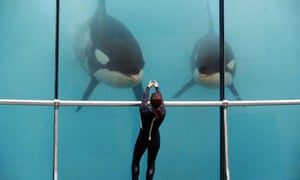March 23, 2016

Schwab Charles Investment Management Inc. raised its stake in SeaWorld Entertainment Inc (NASDAQ:SEAS) by 0.1% during the fourth quarter, according to its most recent filing with the Securities and Exchange Commission. The institutional investor owned 380,903 shares of the company’s stock after buying an additional 547 shares during the period. Schwab Charles Investment Management Inc. owned approximately 0.45% of SeaWorld Entertainment worth $7,500,000 as of its most recent filing with the SEC.
Other large investors have also made changes to their positions in the company. Morgan Stanley increased its stake in shares of SeaWorld Entertainment by 107.1% in the fourth quarter. Morgan Stanley now owns 294,965 shares of the company’s stock valued at $5,808,000 after buying an additional 152,573 shares during the last quarter. New York State Common Retirement Fund increased its stake in shares of SeaWorld Entertainment by 420.7% in the fourth quarter. New York State Common Retirement Fund now owns 324,909 shares of the company’s stock valued at $6,397,000 after buying an additional 262,509 shares during the last quarter. Clark Estates Inc. NY acquired a new stake in shares of SeaWorld Entertainment during the fourth quarter valued at $1,219,000. Penn Capital Management Co. Inc. increased its stake in shares of SeaWorld Entertainment by 527.7% in the fourth quarter. Penn Capital Management Co. Inc. now owns 992,221 shares of the company’s stock valued at $19,537,000 after buying an additional 834,152 shares during the last quarter. Finally, Rhumbline Advisers increased its stake in shares of SeaWorld Entertainment by 6.2% in the fourth quarter. Rhumbline Advisers now owns 65,549 shares of the company’s stock valued at $1,291,000 after buying an additional 3,815 shares during the last quarter.
Shares of SeaWorld Entertainment Inc (NASDAQ:SEAS) opened at 20.01 on Wednesday. The firm has a market cap of $1.68 billion and a PE ratio of 35.11. The company’s 50-day moving average is $18.34 and its 200-day moving average is $18.45. SeaWorld Entertainment Inc has a 52 week low of $16.86 and a 52 week high of $22.68.
SeaWorld Entertainment (NASDAQ:SEAS) last announced its quarterly earnings results on Thursday, February 25th. The company reported ($0.11) earnings per share for the quarter, missing analysts’ consensus estimates of ($0.10) by $0.01. During the same quarter last year, the business posted ($0.21) earnings per share. The business had revenue of $267.90 million for the quarter, compared to analysts’ expectations of $267.70 million. The firm’s quarterly revenue was up 1.3% compared to the same quarter last year. Analysts forecast that SeaWorld Entertainment Inc will post $0.82 EPS for the current fiscal year.
The firm also recently declared a quarterly dividend, which will be paid on Friday, April 1st. Shareholders of record on Monday, March 14th will be given a dividend of $0.21 per share. The ex-dividend date is Thursday, March 10th. This represents a $0.84 dividend on an annualized basis and a yield of 4.20%.
Several brokerages recently weighed in on SEAS. FBR & Co. reaffirmed a “buy” rating on shares of SeaWorld Entertainment in a research note on Monday, December 28th. Vetrdowngraded shares of SeaWorld Entertainment from a “strong-buy” rating to a “buy” rating and set a $21.33 price objective on the stock. in a research report on Tuesday, December 22nd. TheStreet raised shares of SeaWorld Entertainment from a “sell” rating to a “hold” rating in a research report on Friday, February 19th. Janney Montgomery Scott initiated coverage on shares of SeaWorld Entertainment in a research report on Thursday, February 4th. They issued a “neutral” rating and a $20.00 price objective on the stock. Finally, Wells Fargo raised shares of SeaWorld Entertainment from a “market perform” rating to an “outperform” rating in a research report on Friday, March 18th. Two research analysts have rated the stock with a sell rating, six have assigned a hold rating, six have given a buy rating and one has assigned a strong buy rating to the stock. SeaWorld Entertainment has a consensus rating of “Hold” and an average price target of $21.83.
SeaWorld Entertainment, Inc (NASDAQ:SEAS) is a theme park and entertainment company. It owns or licenses a portfolio of brands including SeaWorld, Shamu and Busch Gardens. It has 11 destination and regional theme parks that are located across the United States.
Source: Financial Market News.com





